In the 1920s, you'd find women's wrap coats as essential attire that beautifully combined comfort and chic elegance. These stylish garments featured loose, flowing silhouettes that complemented flapper dresses perfectly. Material choices like silk, velvet, and brocade showcased exceptional craftsmanship. Designs often included striking elements like oversized shawl collars and kimono sleeves, influenced by the Art Deco movement. Whether it was a beaded evening cape or a winter coat lined with faux fur, each piece added sophistication to any outfit. Exploring further will reveal how these wraps not only transformed fashion but also mirrored the cultural shifts of the era.
Historical Overview of Wrap Coats
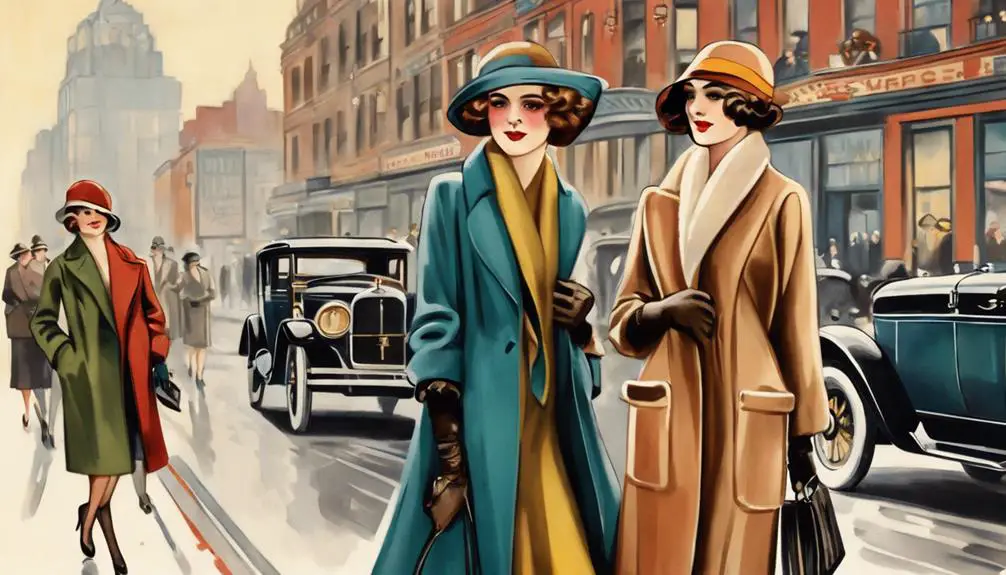
In the vibrant world of 1920s fashion, wrap coats emerged as a significant style, seamlessly blending comfort with elegance. These fashionable outerwear pieces were characterized by their loose, flowing silhouettes, perfectly complementing the era's iconic flapper dresses. As you investigate the 1920s, you'll notice how wrap coats became essential for evening wear, offering both warmth and sophistication. Vintage clothing labels from this era often highlight the craftsmanship and unique designs associated with wrap coats, making them highly sought after by collectors vintage clothing labels.
Crafted from luxurious materials like silk, velvet, and brocade, these coats often featured decorative elements such as intricate embroidery and sparkling beading that enhanced their glamorous appeal. Popular designs included full-length raccoon coats and cocoon styles, which showcased an elegant drape while maintaining a relaxed fit. The use of shawl collars and oversized cuffs, frequently trimmed with fur, reflected the opulence of the time.
For summer evenings, lightweight wraps made from chiffon and similar fabrics became staples, allowing for versatile layering with other garments. This adaptability made wrap coats not just a fashion statement but also a practical choice for the modern woman of the 1920s, highlighting her desire for both style and functionality. As you explore further, you'll see how these coats encapsulated the spirit of the era.
Key Styles of the 1920s
While exploring the key styles of the 1920s, you'll discover that wrap coats played a pivotal role in shaping women's fashion during this transformative decade. One of the standout features was the shawl lapel blazers, which offered a casual yet sophisticated allure. Made from luxurious materials like velvet and brocade, these blazers enhanced the elegance of everyday wear.
As evening events became more glamorous, beaded evening capes emerged as a must-have accessory. These capes, often adorned with intricate beadwork and fringes, added a touch of opulence to formal outfits, making them perfect for parties and special occasions. The allure of these capes lay in their ability to elevate even the simplest dresses, reflecting the era's fascination with luxury.
For seasonal versatility, lightweight chiffon wraps were popular in summer, providing comfort without sacrificing style. In contrast, winter coats often featured faux fur, combining warmth and luxury seamlessly. This emphasis on both aesthetics and functionality showcased how wrap coats not only defined individual style but also adapted to the changing needs of women during the 1920s, making them iconic pieces of the decade's fashion landscape.
Popular Fabrics and Materials
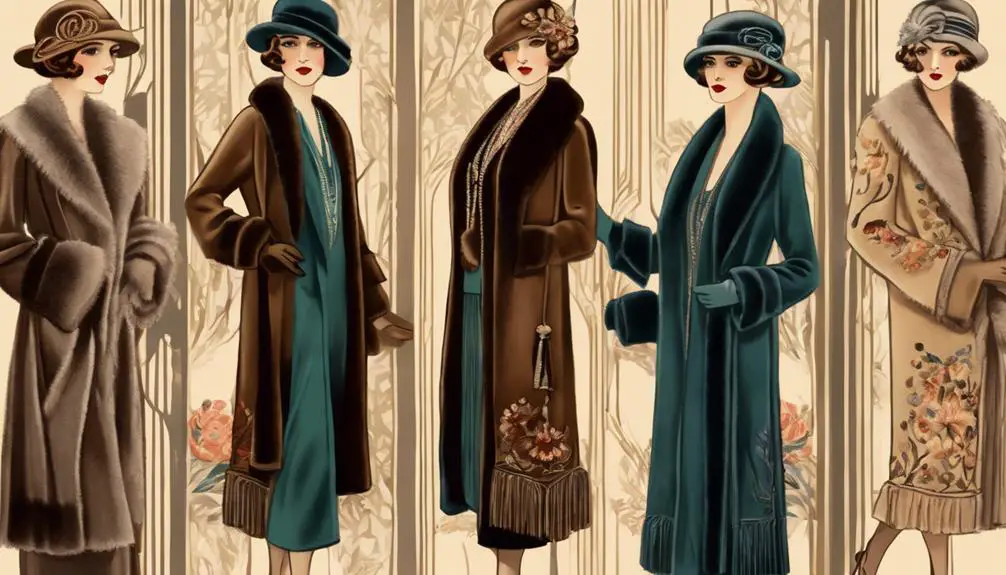
The fabrics and materials used in women's wrap coats during the 1920s were a demonstration of the era's commitment to luxury and style. Silk and velvet dominated the scene, bringing rich textures and an elegant appearance that perfectly complemented the flapper silhouette. These luxurious materials not only exuded sophistication, but they also highlighted the wearer's refined taste.
Faux fur emerged as a popular choice for linings and trims, providing warmth and glamour, especially for evening wraps designed for cooler nights. Its ability to mimic the opulence of real fur without the ethical implications made it a fashionable alternative. Additionally, brocade featured prominently in wrap coat designs, showcasing intricate patterns that captured the essence of the Roaring Twenties.
For warmer occasions, lightweight fabrics like chiffon were favored, allowing graceful movement and an airy feel when layered over sleeveless gowns. Common embellishments like beading, embroidery, and fringe further enhanced the decorative appeal, aligning with the decade's penchant for extravagant detail. Altogether, these materials not only defined the aesthetic of wrap coats but also reflected the era's cultural shift toward modernity and elegance.
Design Elements and Features
Numerous design elements and features characterized women's wrap coats in the 1920s, reflecting both the era's bold aesthetics and evolving fashion sensibilities. The wrap coat became a staple for women seeking both elegance and comfort, showcasing a blend of practicality and high style.
Key design elements included:
- Large shawl collars that added drama and warmth.
- Oversized cuffs enhancing the overall silhouette.
- Luxurious fabrics like silk, velvet, and brocade that emphasized opulence.
- Kimono sleeves reflecting Eastern influences, creating fluid lines and ease of movement.
- Minimal closures, allowing the coats to be worn open for a relaxed, elegant effect.
These features not only made the wrap coats visually appealing but also practical for the varied lifestyles of women during the 1920s. The use of decorative elements like embroidery, tassels, and metallic braids elevated the aesthetic, ensuring that each piece was unique. As you explore the wrap coats of this era, consider how these design elements not only represented fashion trends but also mirrored the cultural shifts occurring at the time, making them timeless pieces of art.
Notable Fashion Trends
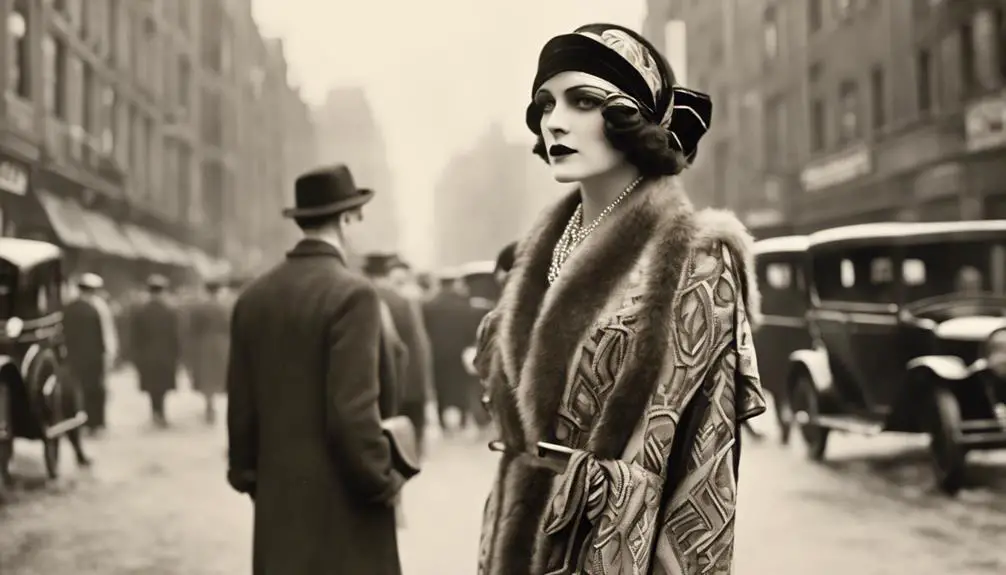
Wrap coats in the 1920s emerged as a defining element of women's fashion, particularly in evening wear, where they accentuated the glamorous silhouettes of the flapper dresses. Among these, the cocoon coat stood out with its loose fit that tapered at the knees, offering a chic yet comfortable option for women. Often crafted from luxurious materials like velvet and brocade, these coats were both stylish and sophisticated.
The era's opulence was reflected in the decorative elements incorporated into evening wraps. Beading, intricate embroidery, and long fringe adorned many designs, enhancing their visual appeal and celebrating the lavish lifestyle of the time. For summer evenings, lightweight chiffon wraps became favored, allowing for ease and breathability, while faux fur options dominated the winter months, merging warmth with elegance.
Art Deco design profoundly influenced these garments, evident in the geometric patterns and detailed embellishments that made wrap coats a fashionable statement piece. This combination of luxurious materials, thoughtful design, and striking embellishments not only defined the style of the decade but also highlighted the evolving role of women in society, as they embraced new freedoms and expressions through fashion.
Iconic Evening Wear
Evening wear in the 1920s encapsulated the spirit of liberation and glamour, inviting women to embrace their newfound freedom with style and confidence. This era celebrated elegant silhouettes and luxurious fabrics, with wraps, capes, and shawls enhancing the allure of flapper dresses. Remarkably, vintage clothing labels from this era often showcase exquisite craftsmanship and attention to detail, reminiscent of pieces like vintage Betty Barclay that exemplify the elegance of the time. You'd find that evening attire wasn't just about aesthetics; it reflected a shift in social dynamics, where women sought both functionality and flair.
Key elements of iconic evening wear included:
- Cocoon coats that draped loosely at the top and tapered at the knees, creating a chic silhouette.
- Elegant evening capes designed to be worn open, often embellished with intricate tassels.
- Beaded evening capes, adorned with shimmering embellishments that caught the light beautifully.
- Rich color palettes featuring shades like black, jade, and sapphire, perfect for dramatic flair.
- Decorative motifs inspired by Art Deco and Egyptian design, reflecting the era's fascination with opulence.
These luxurious pieces not only provided warmth during social events but also served as a statement of individuality, allowing women to express their style amidst the vibrant nightlife of the 1920s.
Seasonal Styling Tips
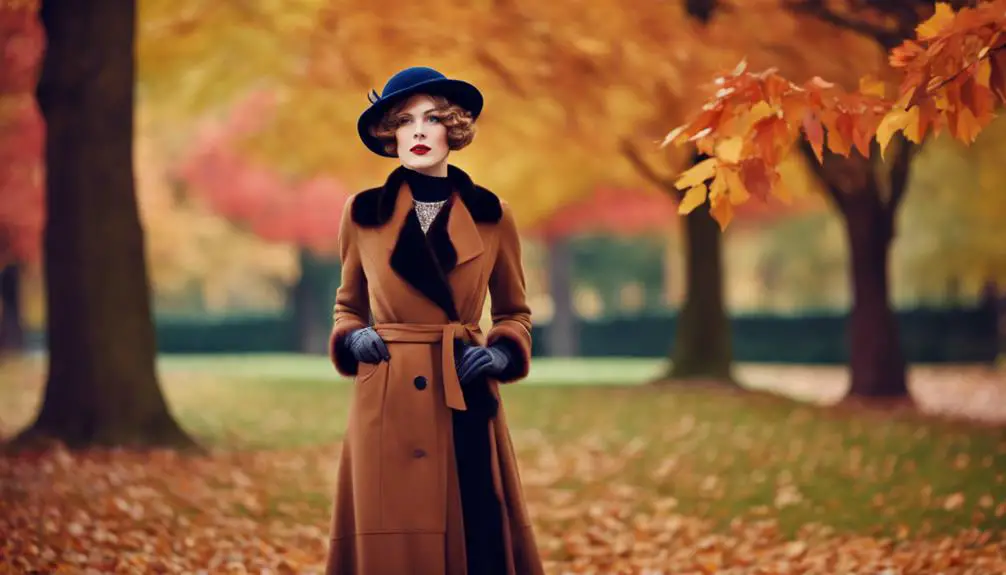
During the 1920s, seasonal styling became an art form, allowing women to adapt their evening wear with sophistication and flair. Each season brought unique opportunities to enhance your look with luxurious fabrics and elegant wraps.
In summer, opt for lightweight shawls made of chiffon or silk, perfect for gracefully draping over sleeveless gowns. As winter approaches, embrace warmth with faux fur wraps that add both comfort and glamour to your ensemble. For colder evenings, layering heavier wool capes over lighter fabrics not only provides insulation but also elevates your style.
Choose glamorous wraps like beaded or sequined shawls to enhance the flapper aesthetic during formal occasions. Seasonal trends favored vibrant colors and opulent textures, making velvet and brocade popular choices for wraps, reflecting the era's luxurious spirit.
| Season | Ideal Wraps | Key Textures |
|---|---|---|
| Spring | Lightweight shawls | Chiffon, Silk |
| Summer | Beaded or sequined shawls | Beaded, Sequined |
| Autumn | Wool capes | Wool, Brocade |
| Winter | Faux fur wraps | Faux fur, Velvet |
With these tips, you'll master the art of seasonal styling in the 1920s.
Price Ranges and Market Value
As you explore the market for women's wrap coats from the 1920s, you'll find a diverse range of prices that reflect both the uniqueness and quality of these vintage garments. Understanding the importance of vintage tag identification can help you appreciate the provenance and value of these pieces. The price ranges can vary dramatically, catering to different budgets and preferences. Here are some notable examples:
- Antique 1920s Egyptian Coat: $850.00
- Black Opera Riding Cape: $48.99
- Antique Evening Cocoon Coat: $1,575.00
- Beautiful 1920s Wool Coat: $195.00
- Vintage 1920s Silk Velvet Opera Coat: $108.00
These vintage options highlight the varying market value; some pieces, like the Antique Evening Cocoon Coat, command high prices due to their rarity and condition. Mid-range options, such as the Beautiful 1920s Wool Coat, offer affordability without compromising on quality. Additionally, shipping costs can influence your total expenditure, ranging from $7.99 for the Black Opera Riding Cape to free shipping on select high-end items. By understanding these price ranges, you can make informed decisions as you seek out that perfect vintage wrap coat to add to your collection.
Unique Vintage Finds
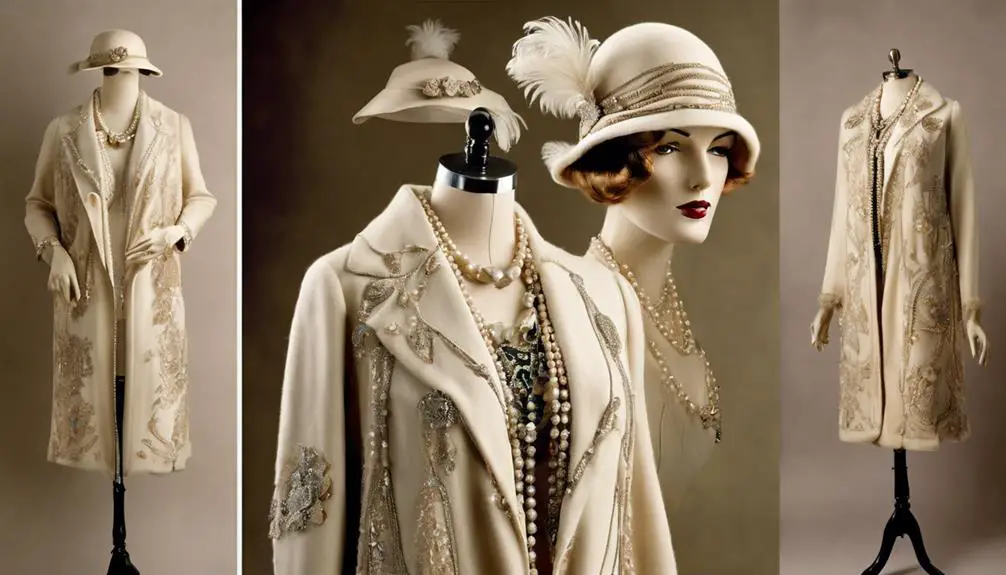
Exploring the world of unique vintage finds from the 1920s reveals an array of exquisite wraps and coats that embody the glamour of the era. These vintage pieces often feature luxurious materials like silk, velvet, and brocade, highlighting the opulence that defined the decade. You'll discover wraps adorned with beaded embellishments and intricate embroidery, emphasizing the artistic flair prevalent in 1920s fashion.
Notable styles, such as the Antique Evening Cocoon Coat and Flapper Chinoiserie Cape, showcase decorative elements, making them perfect for evening wear and special occasions. Design characteristics like oversized shawl collars and kimono sleeves are common, reflecting the era's preference for relaxed silhouettes and minimal closures.
The Antique 1920s Cocoon Coat currently commands a price of $1,975.00, underscoring the high value placed on unique vintage items that capture this distinctive aesthetic. If you're on the hunt for something more affordable, consider the Black Opera Riding Cape at $48.99, plus shipping. These vintage wraps and coats are more accessible than ever, inviting collectors and fashion enthusiasts to embrace a piece of history and experience the elegance of the 1920s.
Cultural Influences on Fashion
Fashion in the 1920s was a vibrant tapestry woven from cultural influences that shaped the era's aesthetic. The rise of evening shawl wraps reflected a fascination with the lavish lifestyles portrayed in literature and cinema, particularly in F. Scott Fitzgerald's "The Great Gatsby." These wraps weren't just garments; they symbolized a new era of elegance and independence for women.
Key influences on fashion during this decade included:
- The Great Gatsby movement, which inspired opulent designs.
- Historical events, like the discovery of King Tut's tomb, introducing Egyptian motifs.
- The Art Deco movement, characterized by geometric patterns and luxurious fabrics.
- Social changes, granting women more independence, leading to practical yet stylish wrap coats.
- Jazz culture and speakeasy nightlife, prompting glamorous evening wraps adorned with beading and fringe.
These cultural currents converged to create a unique fashion landscape, where the evening shawl wrap became essential for expressing individuality and sophistication. In this scenario, wrap coats not only enhanced fashion but also mirrored the shifting dynamics of women's roles in society, seamlessly blending practicality with the allure of the Jazz Age.
Frequently Asked Questions
What Coats Were Popular in the 1920s?
In the 1920s, you'd notice raccoon coats and cocoon silhouettes gaining popularity. Flappers favored elegant wraps and evening coats adorned with luxurious fabrics, showcasing designs that embraced both opulence and the era's evolving fashion landscape.
Did Flapper Girls Wear Fur Coats?
Yes, flapper girls often wore luxurious fur coats, showcasing their wealth and sophistication. These stylish garments complemented their loose silhouettes, enhancing their glamorous appearance while reflecting the opulent fashion trends of the 1920s.
What Was the Raccoon Coat in the 1920s?
The raccoon coat in the 1920s symbolized luxury and status, often worn by college students and socialites. Its full-length design, luxurious fur, and large shawl collar made it a fashionable statement during the Roaring Twenties.
What Type of Animal Fur Coat Was Popular in the 1920's?
In the 1920s, you'd find raccoon, mink, and fox fur coats dominating fashion. These luxurious materials signified wealth and style, appealing to those seeking elegance, warmth, and a statement piece for social gatherings and evening outings.
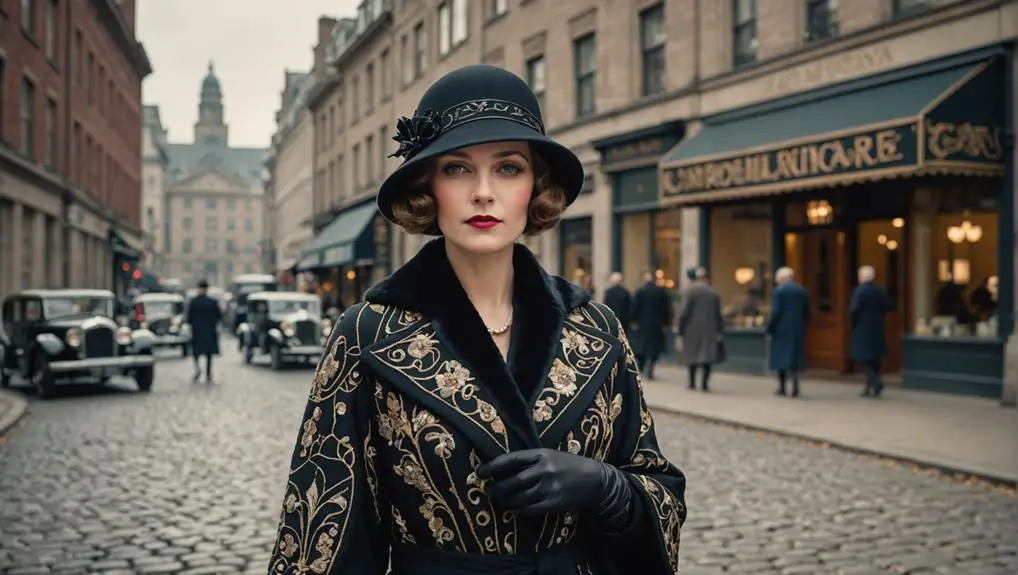

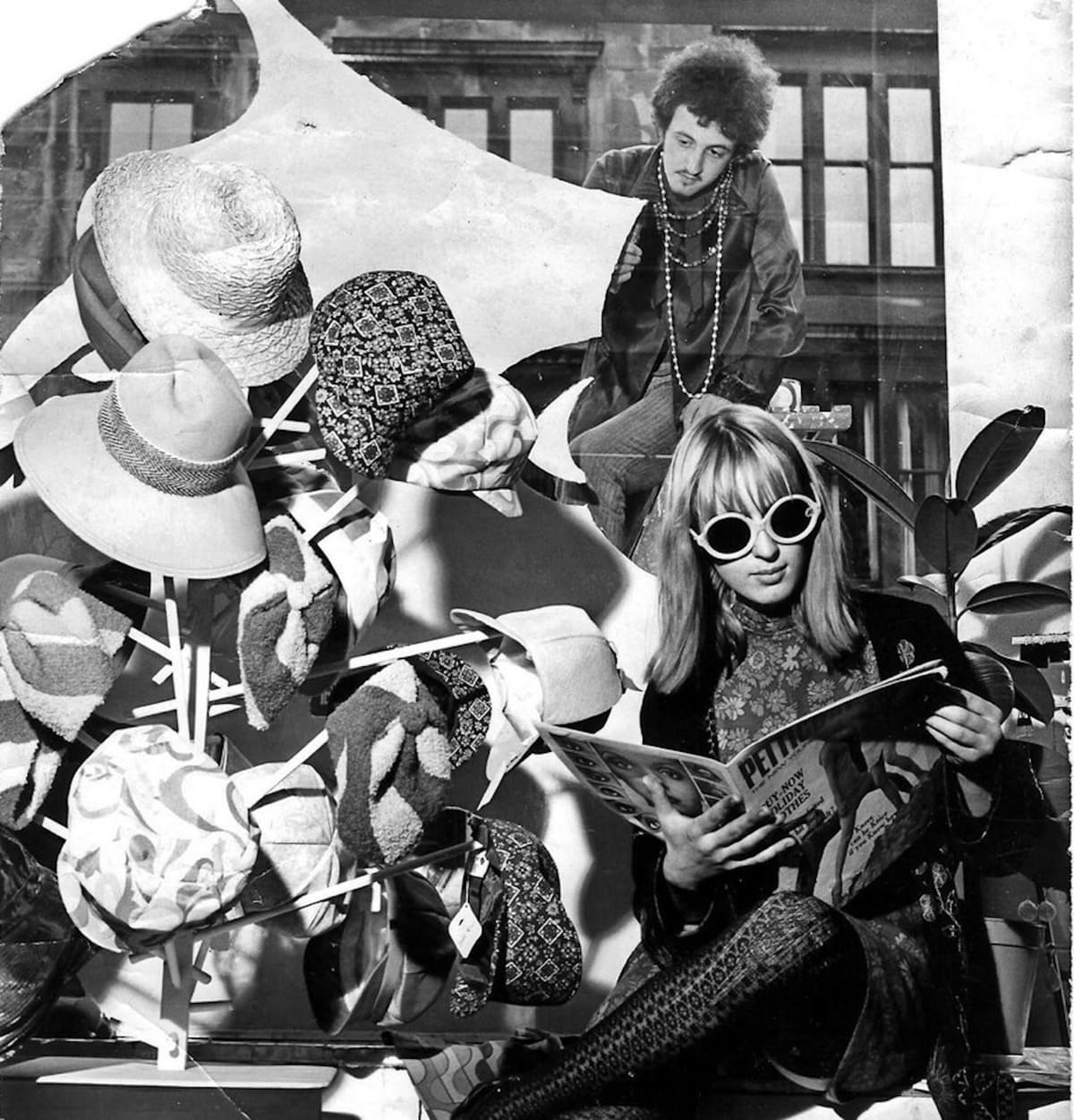
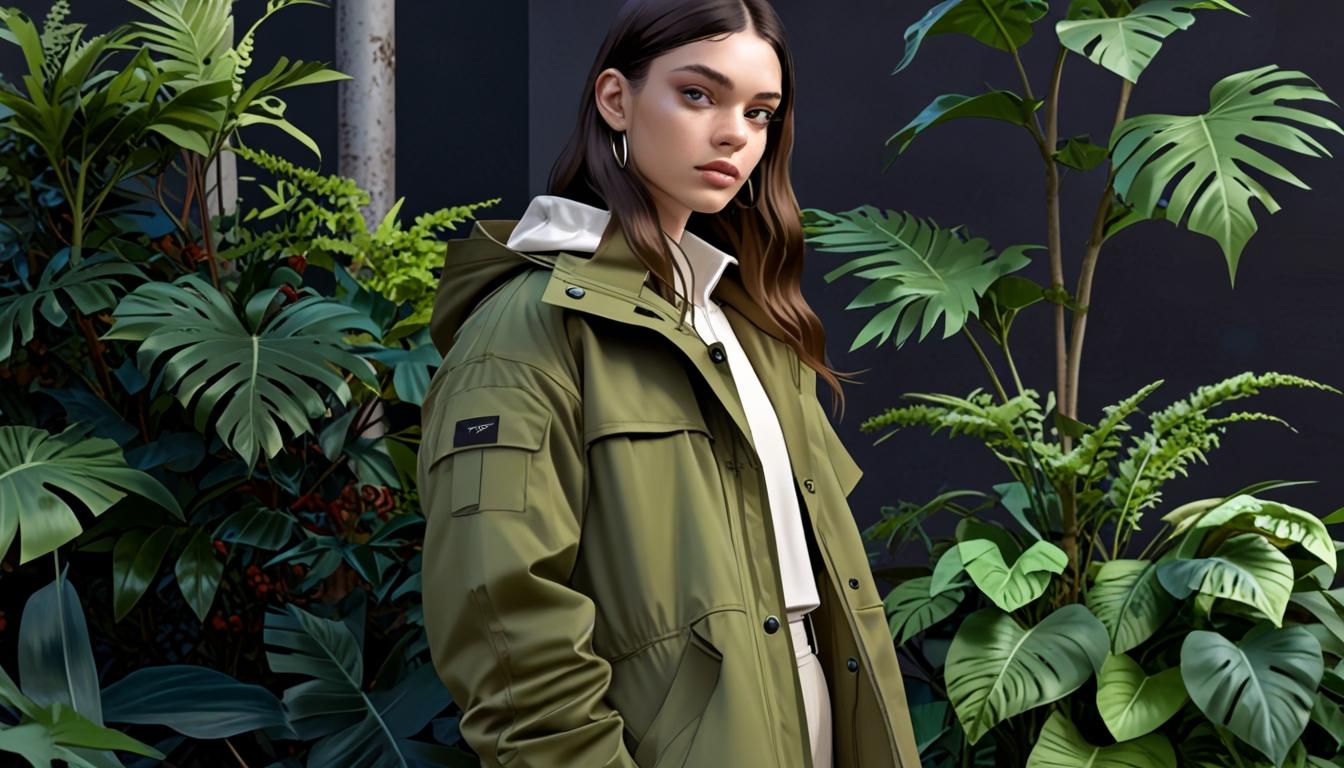
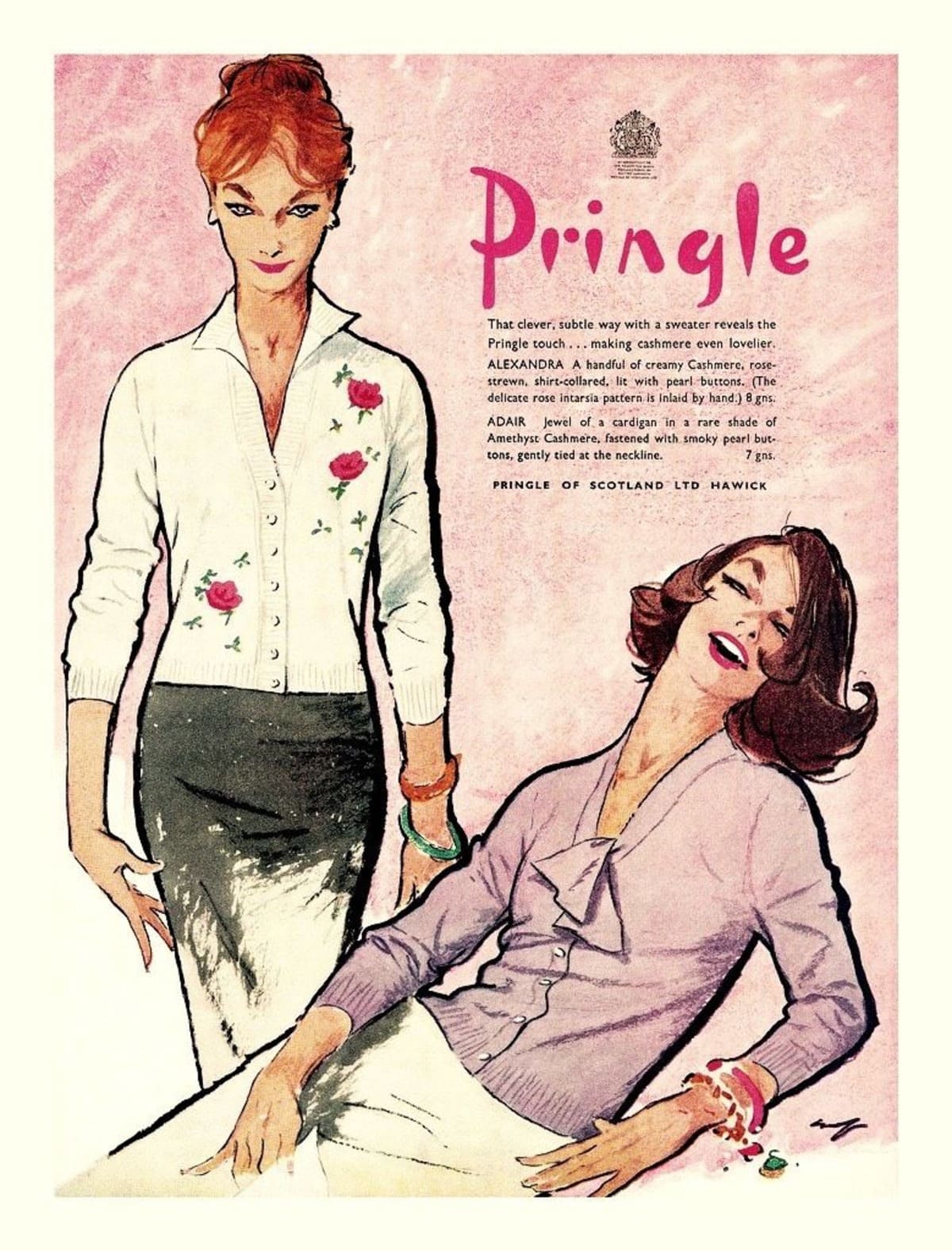
Would you be desirous about exchanging links?